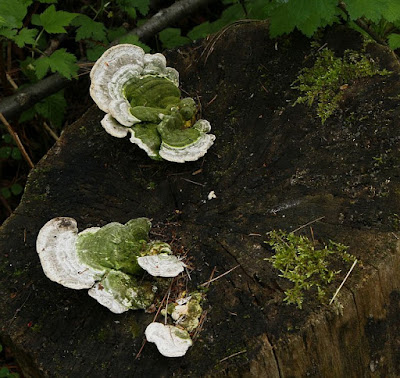Oshawa Second Marsh
May 24th, 2015
May almost slipped by without my visiting the marsh... the wrong month for me to miss. A lot appears in May. I think I caught most of what happens, but just.
I can't pass a nice Dryad's Saddle and not take a shot.
The Mayapples are well on their way. Many seem taller than usual this year.
Wild Geranium stand out in their soft pink.
Most trees have reached full leaf.
On warmer days, I always look for the turtles in the water-channel by the berm. I wasn't disappointed today.
A fishing rod in one hand, a wagon with his son in it in the other, and accompanied by his daughter—nice to see a fisherman bring his kids along. We compared notes on the turtles. The young girl said she had a turtle at home. She was quite happy to see one in the wild.
This one must have picked up the red coloring from something in the water.
I don't see many Puffball mushrooms. These are the small variety, about an inch across. I'd love to see a giant one. Saw one as a kid somewhere, but none since.
A Trumpeter male on guard as the female was feeding. He was sporting two tags.
A spikey hair-do for the water.
Not much of a shot but I think it's something we've all seen—a small bird harassing a large one that is too close to its territory. It always makes me think of war movies where the smaller fighter planes are attacking a bomber.
Foam Flower amongst some Mayapples... thanks Michael.
The section of the boardwalk between the berm and the bridge over Farewell Creek is in a sad state of disrepair. In fact, access to it is blocked off from the bridge side, though not from the berm side.
It's just too much of a battle with nature for the volunteers and donors to keep up with. Each year that Farewell Creek floods just makes things worse.
It'll be a sad day if the authorities feel that they have to limit access to some sections of the marsh due to safety issues.
I was looking closely in the area where the Small Yellow Ladyslipper orchids are usually found. Didn't see a single one. I was disappointed, thinking I'd missed them this year.
Then, on the way back, this grouping of them jumped out at me, not 5 feet from the boardwalk. I sometimes wonder about my powers of observation. I figure I must have been looking left at the time, when I should've looked right. But I thought I was sweeping both sides of the boardwalk. Whatever.
In an earlier post I said Mayapples were probably my favourite wildflower in our area. I forgot about the Ladyslippers. So Mayapples slip to #2.
Their curly, burgundy sepals complement the rich yellow of the slippers.
Flying in formation. The texture and lines of their leaves complement the blossoms. A beautiful wildflower all round.
Side view: Looking shy, with a sepal draped over the puffy slipper.
They're a treat to come across. The slipper is about an inch long. The reddish spots inside the slipper add to its beauty.
I do get carried away with shots of them, but they offer such a variety of profiles.
They're not considered rare, but they're not common either. I expect most people have never seen one. If you do come across some, linger and enjoy their beauty.
June is closing in fast. Where does the time go?
A link to a page that has my past posts re the marsh, in one place rather than scattered throughout this blog...




















































